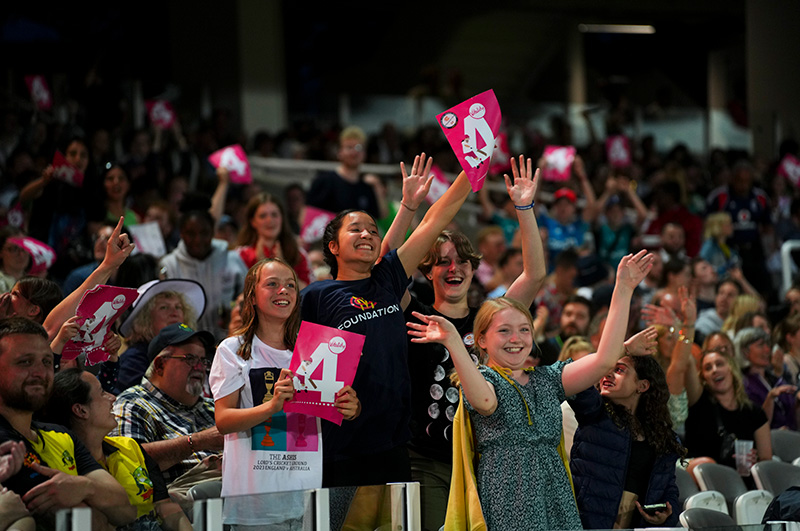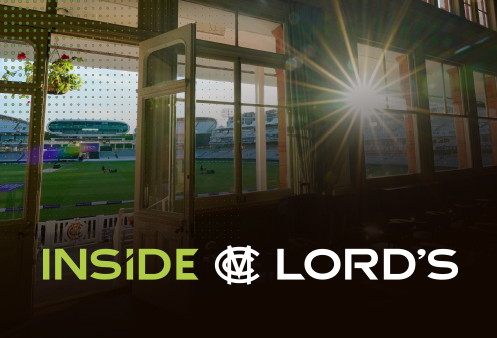19.1 Determining the boundary of the field of play
19.1.1 Before the toss, the umpires shall determine the boundary of the field of play, which shall be fixed for the duration of the match. See Law 2.3.1.4 (Consultation with captains).
19.1.2 The boundary shall be determined such that no part of any sight-screen will, at any stage of the match, be within the field of play.
19.2 Identifying and marking the boundary
19.2.1 Wherever practicable, the boundary shall be marked by means of a continuous white line or by an object in contact with the ground.
19.2.2 If the boundary is marked by means of a white line,
19.2.2.1 the edge of the line nearest the pitch shall be the boundary.
19.2.2.2 an object such as a flag, post or board, used merely to highlight the position of a line marked on the ground, must be placed beyond the boundary and is not itself to be regarded as being the boundary.
19.2.3 If the boundary is marked by means of an object that is in contact with the ground the boundary will be the edge of the grounded part of the object which is nearest the pitch.
19.2.4 Where there is no white line or object providing continuous marking, objects such as flags, posts or boards may be used to mark specific points on the boundary. The boundary shall be the imaginary straight line on the ground joining the two nearest marked points.
19.2.5 A boundary that cannot be identified as in 19.2.2, 19.2.3 or 19.2.4 shall be determined by the umpires before the toss.
19.2.6 An obstacle within the field of play, other than as in 19.2.7, shall not be regarded as a boundary unless so determined by the umpires before the toss. See Law 2.3.1.4 (Consultation with captains).
19.2.7 A person, animal or object coming onto, or coming over the field of play while the ball is in play shall not be regarded as a boundary unless the umpires determine otherwise at the time that contact between the ball and such a person, animal or object is made. The decision shall be made for each separate occurrence. See also Law 20.4.2.12 (Umpire calling and signalling Dead ball).
19.3 Restoring the boundary
If a solid object used to mark the boundary is disturbed for any reason, then
19.3.1 the boundary shall be considered to be in its original position.
19.3.2 the object shall be returned to its original position as soon as is practicable; if play is taking place, this shall be as soon as the ball is dead.
19.3.3 if some part of a fence or other marker has come within the field of play, that part shall be removed from the field of play as soon as is practicable; if play is taking place, this shall be as soon as the ball is dead.
19.4 Ball grounded beyond the boundary
19.4.1 The ball in play is grounded beyond the boundary if it touches
- the boundary or any part of an object used to mark the boundary;
- the ground beyond the boundary;
- any object that is grounded beyond the boundary.
19.4.2 The ball in play is to be regarded as being grounded beyond the boundary if
- a fielder, grounded beyond the boundary as in 19.5, touches the ball;
- a fielder, after catching the ball within the boundary, becomes grounded beyond the boundary while in contact with the ball, before completing the catch.
19.5 Fielder grounded beyond the boundary
19.5.1 A fielder is grounded beyond the boundary if some part of his/her person is in contact with any of the following:
- the boundary or any part of an object used to mark the boundary;
- the ground beyond the boundary;
- any object that is in contact with the ground beyond the boundary;
- another fielder who is grounded beyond the boundary, if the umpire considers that it was the intention of either fielder that the contact should assist in the fielding of the ball.
19.5.2 A fielder who is not in contact with the ground is considered to be grounded beyond the boundary if his/her final contact with the ground, before his/her first contact with the ball after it has been delivered by the bowler, was not entirely within the boundary.
19.6 Boundary allowances
19.6.1 Before the toss the umpires shall determine the runs to be allowed for boundaries with both captains. In deciding the allowances the umpires and captains shall be guided by the prevailing custom of the ground.
19.6.2 Unless determined differently under 19.6.1, 6 runs shall be allowed for a boundary 6; and 4 runs for a boundary 4. See also 19.7.
19.7 Runs scored from boundaries
19.7.1 A Boundary 6 will be scored if and only if the ball has been struck by the bat and is first grounded beyond the boundary without having been in contact with the ground within the field of play. This shall apply even if the ball has previously touched a fielder.
19.7.2 A Boundary 4 will be scored when a ball that is grounded beyond the boundary
- whether struck by the bat or not, was first grounded within the boundary, or
- has not been struck by the bat.
19.7.3 When a boundary is scored, the batting side, except in the circumstances of 19.8, shall be awarded whichever is the greater of
19.7.3.1 the allowance for the boundary
19.7.3.2 the runs completed by the batters together with the run in progress if they had already crossed at the instant the boundary is scored.
19.7.4 When the runs in 19.7.3.2 exceed the boundary allowance they shall replace the boundary allowance for the purposes of Law 18.12.2 (Batter returning to wicket he/she has left).
19.7.5 The scoring of Penalty runs by either side is not affected by the scoring of a boundary.
19.8 Overthrow or wilful act of fielder
If the boundary results from an overthrow or from the wilful act of a fielder, the runs scored shall be
any runs for penalties awarded to either side
and the allowance for the boundary
and the runs completed by the batters, together with the run in progress if they had
already crossed at the instant of the throw or act.
Law 18.12.2 (Batter returning to wicket he/she has left) shall apply as from the instant of the throw or act.
© Marylebone Cricket Club 2017




